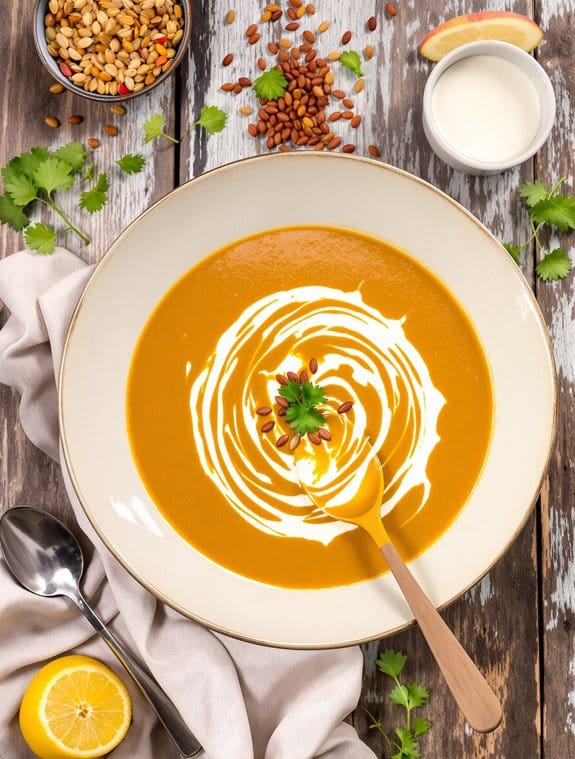Why You’ll Love this Aromatic Mulligatawny Soup
Once you smell the aromatic spices of this Mulligatawny soup simmering on your stove, you’ll understand why it’s become one of my absolute favorite recipes. The combination of coriander, cumin, turmeric, and cardamom creates a symphony that dances through your kitchen.
What makes this soup special? It’s the perfect balance of creamy coconut milk against earthy lentils, with just enough heat from the chilies to warm you without overwhelming. The apple adds a subtle sweetness that counterpoints the savory elements. And can we talk about versatility? Make it ahead, freeze portions for busy weeknights, or impress dinner guests with minimal effort. Pure comfort in a bowl.
What Ingredients are in Aromatic Mulligatawny Soup?
The real magic of any great Mulligatawny soup lies in its carefully balanced ingredients. This aromatic version combines a generous blend of warm spices with hearty lentils and the unexpected addition of apple, which adds a subtle sweetness that perfectly complements the savory elements. The coconut milk creates that velvety texture we all crave in a comfort soup, while fresh herbs brighten the entire dish. I’m getting hungry just thinking about all these flavors coming together in one pot!
- 1 tablespoon vegetable oil
- 1 large onion, chopped
- 4 garlic cloves, crushed
- 1 tablespoon fresh ginger, grated
- 2 fresh small red chilies, chopped
- 2 teaspoons ground coriander
- 1 teaspoon ground cumin
- 1 teaspoon ground turmeric
- 1 tablespoon mild curry powder
- 1/4 teaspoon cinnamon
- 6 cardamom pods, bruised
- 1 cup red lentils
- 7 cups chicken or vegetable stock
- 1 large potato, peeled and chopped
- 1 large apple, peeled, cored and chopped
- 2 cups coconut milk
- 2 tablespoons lemon juice
- 2 tablespoons chopped fresh coriander leaves
When shopping for these ingredients, try to find the freshest spices possible—they really do make a difference in the final flavor profile. If you can’t find fresh red chilies, you can substitute with a pinch of dried chili flakes, adjusting to your heat preference. And while red lentils are traditional for this recipe (they break down beautifully to create that classic texture), you could experiment with yellow lentils in a pinch. The coconut milk can be full-fat or light depending on how creamy you want your finished soup to be. Isn’t it wonderful how adaptable this recipe is?
How to Make this Aromatic Mulligatawny Soup

Making this vibrant soup starts with building a fragrant base of spices. Heat 1 tablespoon of vegetable oil in a large pan, then add 1 large chopped onion, 4 crushed garlic cloves, 1 tablespoon of freshly grated ginger, and 2 chopped small red chilies. This aromatic foundation is what gives Mulligatawny its distinctive character.
Now for the spice magic—add 2 teaspoons of ground coriander, 1 teaspoon of ground cumin, 1 teaspoon of ground turmeric, 1 tablespoon of mild curry powder, 1/4 teaspoon of cinnamon, and 6 bruised cardamom pods. Cook this mixture, stirring frequently, for about 5 minutes until the onions have softened and your kitchen smells absolutely heavenly. Can you imagine that aroma wafting through your home right now?
Once your spice base is ready, it’s time to add 1 cup of red lentils, 7 cups of chicken or vegetable stock (vegetable works beautifully for a plant-based version), 1 large peeled and chopped potato, and 1 large peeled, cored, and chopped apple. The apple might seem unusual in a savory soup, but trust me, it adds the perfect hint of sweetness that balances the spices.
Bring everything to a simmer, cover the pot, and let it cook for about 20 minutes, or until both the potato and lentils are tender. The lentils will break down slightly, helping to thicken the soup naturally.
The final transformation happens when you process the soup until smooth—either with an immersion blender right in the pot (so much easier) or carefully transferring batches to a blender. Return the silky mixture to the pan and stir in 2 cups of coconut milk for that luxurious creaminess, 2 tablespoons of fresh lemon juice for brightness, and 2 tablespoons of chopped fresh coriander leaves.
A gentle warming is all that’s needed now before serving. And here’s a little secret that makes this soup even better—you can prepare it a day ahead, allowing those complex flavors to meld and deepen overnight. Isn’t it wonderful when a dish actually improves with a little patience?
Aromatic Mulligatawny Soup Substitutions and Variations
Flexibility shines as one of the greatest virtues of Mulligatawny soup, making it perfect for creative cooks and those working with limited pantry ingredients.
I often swap red lentils for yellow when my pantry demands it, or use butternut squash instead of potato for a sweeter profile. No coconut milk? Regular milk with a dash of coconut extract works in a pinch.
For protein variations, I’ve added shredded chicken, diced tofu, or even a handful of chickpeas. Sometimes I toss in spinach or kale at the end for extra nutrients.
Spice-wise, you can dial the heat up or down by adjusting those little red chilies. Your kitchen, your rules.
What to Serve with Aromatic Mulligatawny Soup
While Mulligatawny soup serves beautifully as a standalone meal, pairing it with complementary sides elevates the dining experience to something truly special.
I love serving warm naan bread or fluffy basmati rice alongside my spicy, aromatic creation—they’re perfect for sopping up every last drop of that coconut-lentil goodness.
A simple cucumber raita offers cooling contrast to the soup’s warming spices.
Sometimes, I’ll add a small side salad with citrus vinaigrette that cuts through the richness.
When I’m feeling fancy, samosas make delightful companions, turning an ordinary weeknight dinner into a mini Indian feast at home.
Final Thoughts
As I’ve journeyed through creating this aromatic Mulligatawny soup over the years, I’ve come to treasure it as more than just a recipe—it’s a sensory experience that connects cultures through flavor.
The mingling of lentils, spices, coconut milk, and fresh herbs creates something truly magical in your kitchen.
What I love most about this dish is its adaptability. Make it ahead, adjust the spice level, or customize with your favorite proteins.
It’s forgiving that way. And isn’t that what makes cooking so fulfilling? The freedom to make something uniquely yours while honoring its rich heritage.

Mulligatawny Soup
Ingredients
Equipment
Method
- Heat vegetable oil in a large pot over medium heat.
- Add chopped onion, crushed garlic, grated ginger, and chopped red chilies. Sauté until onions begin to soften, about 3 minutes.
- Add ground coriander, ground cumin, turmeric, curry powder, cinnamon, and bruised cardamom pods. Cook while stirring frequently for about 5 minutes until the onions are completely soft and the spices are fragrant.
- Stir in the red lentils, stock, chopped potato, and chopped apple. Bring the mixture to a simmer.
- Cover the pot and cook for approximately 20 minutes, or until both the potato and lentils are tender.
- Remove from heat and blend the soup until smooth using an immersion blender, or carefully transfer in batches to a regular blender.
- Return the blended soup to the pot and stir in the coconut milk, lemon juice, and chopped fresh coriander leaves.
- Gently warm the soup before serving. Taste and adjust seasoning if necessary.



